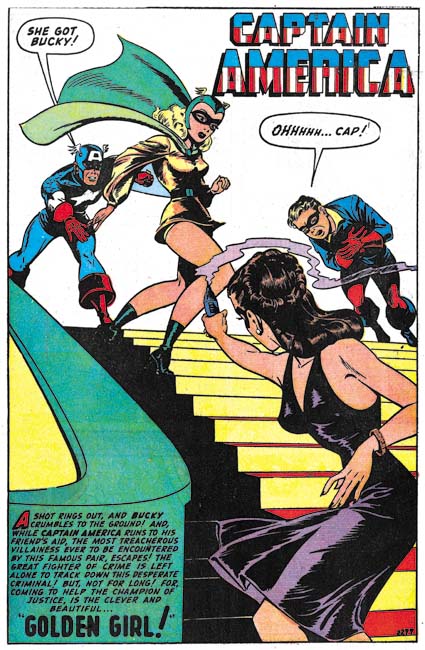
Captain America #66 (April 1948), “Golden Girl”, art by Syd Shores, 2299
Captain America had a shield to protect himself against flying bullets but poor Bucky did not. Despite this lack of protection Bucky managed to survive seven years with the single mishap of once been shot with an arrow by the Red Skull. Now Bucky’s luck has run out. Of course today he would have killed off but during the golden age of comics heroes did not come back from the dead so instead Bucky was just severely wounded. But back then, and it is still true today, death or injury were both a means of trying to boasts comic book sales. With Bucky out of commission, Captain America turned to Betsy Ross to become Golden Girl, his new partner. Syd Shores provides an impressive splash but the villainess seems to have fired not at Bucky but the Golden Girl instead.
The backup story still features Bucky. Prefixes have been dropped from the job numbers which seem to have continued from the series that previously used ‘SL’. The “Golden Girl” story has job number 2299 while “Swords of the Cavaliers” was number 1708. Thus this story appears to have been older material that would be used up while it still could be.

Captain America #67 (July 1948), “The Secret Behind the Mirror”, art by Syd Shores, 2189
“The Secret Behind the Mirror” was not the best Captain America art that Syd Shores provided but it would be the last (at least during the golden age). Shores removal from Captain America certainly was not a reflection on this artistic talent. Syd was one of the best artists to pencil Cap during the golden age exceeded only by Jack Kirby and Al Avison. Superheroes in general, and Captain America in particular, were in a decline and Shores was transferred to other more lucrative titles. Unfortunately the artists who were left to take his place were just not nearly as talented.

Captain America #68 (September 1948), “The Enigma of the Death Doll”, art by an unidentified artist, 2210
Not only had Syd Shores departed from the title but full page splashes disappeared as well. Thus ended a long series of really impressive comic book art. I am not contending that all the Captain America splashes were first rate pieces of art but a great number of them were. As the case with the period covered in the last chapter, none of the art was signed and for the most part I have really no idea what artists to credit the work to.
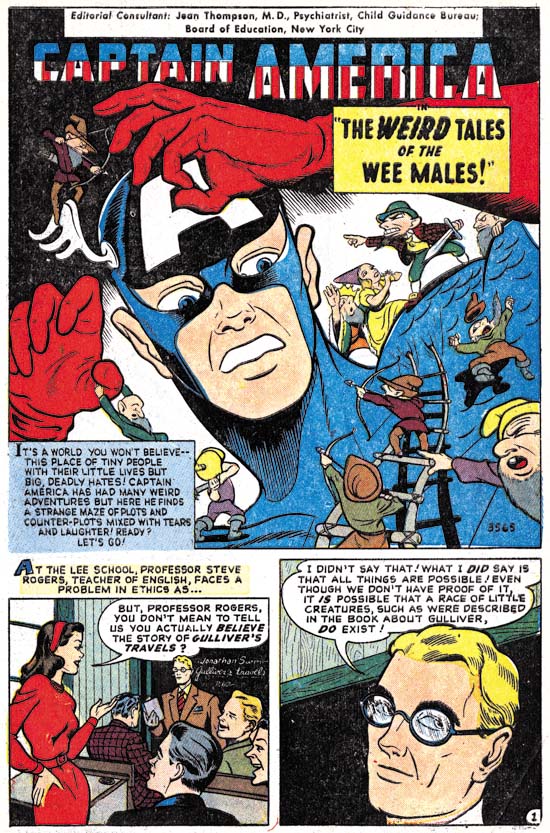
Captain America #69 (November 1948), “The Weird Tales of the Wee Males”, art by an unidentified artist, 3563
Golden Girl was introduced in the hope of increasing sales. But that was not the only attempt to improve the title’s popularity. After years of stories of Captain America versus spies and criminals the title began to include more fantastic stories. Actually such stories were not totally new for Captain America as Simon and Kirby had included stories with a distinct horror aspect. Captain America #10 was the last issue that Simon and Kirby had completed but that had already created a double page splash for issue #11 with Captain America amidst a host of very small people. Ironically years later “The Weird Tales of the Wee Males” returned to this same theme. Normally I would not consider the artist used for this story as a particularly good match for Captain America but he does such a marvelous job on the “Wee Males”. I am not claiming this feature is a masterpiece but it is full of fun and marks the beginning of some imaginative stories.
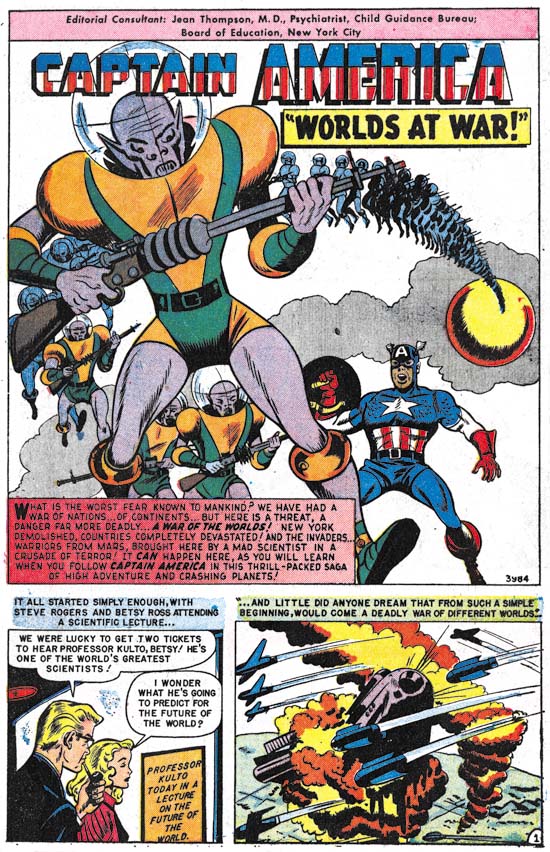
Captain America #70 (January 1949), “Worlds at War”, art by an unidentified artist, 3984
Captain America versus Martians. What kid could resist this? I know I can’t. Perhaps the unidentified artist may not have been the most masterful drawer of Captain America but this is another story saved by a imaginative writer. Not Pulitzer Prize material but much better than the by now stale run of common criminals.

Captain America #70 (January 1949), “The Man Who Knew Everything”, art by Peter Tomlinson?, 4248
Unfortunately “The Man Who Knew Everything” is not as interesting as “The Weird Tales of the Wee Males” or “Worlds at War” and normally I would pass it by without a mention. During this period Captain America was drawn by a number of artists that remain unidentified. It would be nice to rectify this situation even though some of the artists were less than stellar. Possible clues can come from unexpected sources. My copy of Captain America #70 has a note accompanying “The Man Who Knew Everything” story to the effect that it was drawn by Peter Tomlinson (or perhaps Tumlinson). By no means am I suggesting that such an attribution should be accepted on face value but I do believe it warrants further investigation. Unfortunately so far I have been unable to locate any information about an artist with that name.

Captain America #71 (March 1949), “Trapped by the Trickster”, art by an unidentified artist, 4615
Bucky’s last appearance in Captain America Comics occurred almost a year before “Trapped by the Trickster”. In an unusual example of continuity during the golden age of comics Bucky is released from the hospital and rejoins with Captain America for an adventure. There is no sign of the Golden Girl and the story ends without any indication as to whether Bucky might appear again. Surely this story was meant to see if there would be some sort of reader response. If that was the purpose apparently either there was little response or most favored the Golden Girl. Bucky would not reappear again during this run of the title.

Captain America #72 (May 1949), art by an unidentified artist
The splash panel for “Murder in the Mind” was nothing more than a very reduced size copy of the cover colored only in yellow. So I will use an image of the actual cover instead. This story is another where Captain America has a rather unorthodox adventure. This time through a special form of hypnosis Cap and the Golden Girl enter the mind of a criminal. Of course such a journey cannot be taken seriously but given that premise what follows is an interesting and inventive story.
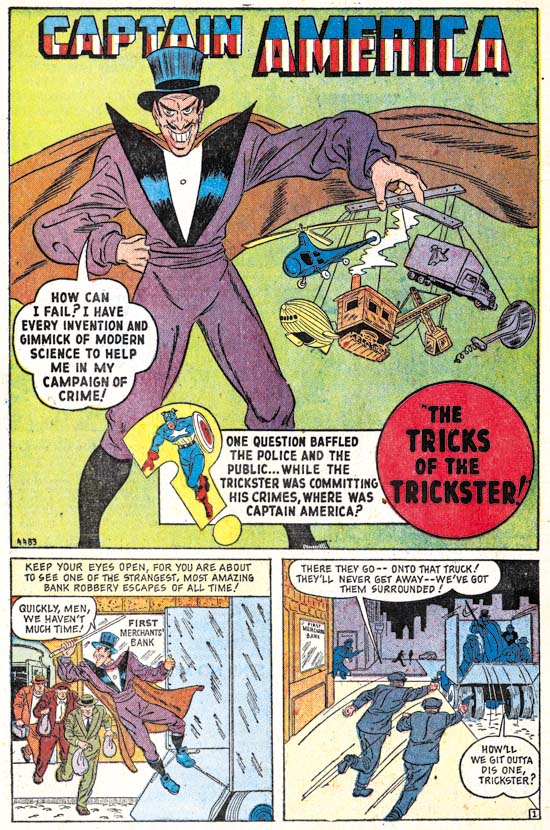
Captain America #72 (May 1949), “The Tricks of the Trickster”, art by an unidentified artist, 4483
The Trickster appear in the last issue yet here he is again. But with the exception of the Red Skull such repeat performances were unusual. This time Captain America was not accompanied by either Bucky or the Gold Girl.
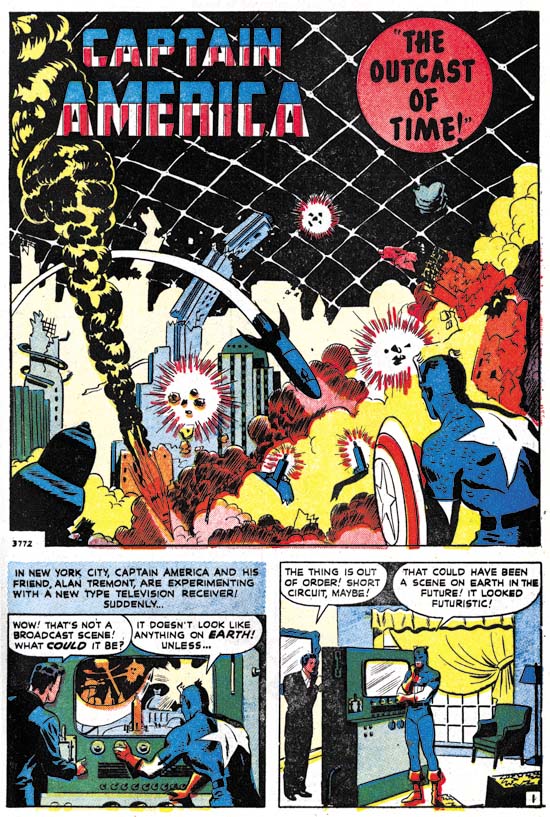
Captain America #73 (July 1949), “The Outcast of Time”, art by an unidentified artist, 3772
“The Outcast of Time” is another imaginative story where Captain America journeys through time. Oddly the GCD attributes this story to Gene Colan. It might bed hard to believe that such a crudely drawn story could have been done by such a master, however Colon would have been quite young at this time. Unfortunately I have not studied Gene Colon’s career and so will leave it to others to determine the accuracy of this surprising attribution.
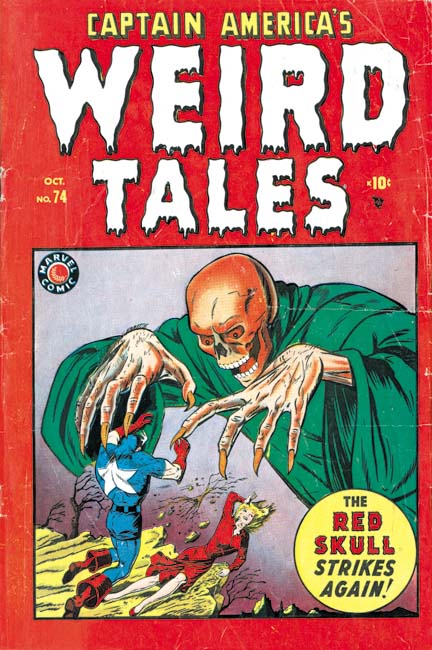
Captain America’s Weird Tales #74 (October 1949), art by Martin Nodell?, 6047
Once again I am going to deviate from my general practice in this serial post and include an image of a cover. As I have mentioned above there is little information available as to who did the art for Captain America during the period covered in this chapter so any evidence about possible artists should not be ignored. GCD has the following comment on this cover:
Updated cover credits from Tony Isabella from Gary Colabuono who was able to glean the information from Marty Nodell’s personal effects (August 6, 2006).
I have also noticed that Atlas Tales also questionably attributes this cover art to Martin Nodell and I will follow their example.
Note the title change from Captain America Comics to Captain America’s Weird Tales with the emphasis largely on the Weird Tales. The backup stories belonged to the horror genre and as mentioned above even the Captain America features were often not typical superhero material.
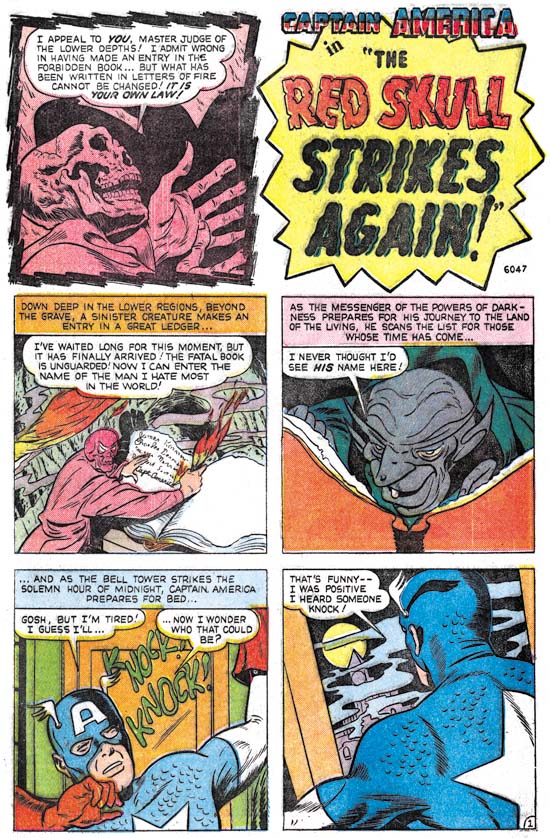
Captain America’s Weird Tales #74 (October 1949), “The Red Skull Strikes Again”, art by an unidentified artist, 6047
It seems fitting that the last Captain America story of the run would feature his old nemesis the Red Skull. Apparently in his last appearance the Red Skull really did die as this story shows him residing in hell. The Red Skull contrives to have Captain America brought down to hell for one last battle. Do I have to say who wins?
Unlike previous issues, Captain America #74 had only a single Cap feature. There was a Captain America’s Weird Tales #75 but it did not include any Captain America stories and so will not be covered here. After a run of nearly eight years Captain America would come to an end. While not every story was a masterpiece it was an interesting run well deserving of being reprinted. Unfortunately at the rate that Marvel is currently releasing the golden age archives of Captain America it will be many, many years before they reprint the entire series. (That is not criticism, it is to Marvel’s credit that they are reprinting so much golden age material.) Next week I hope to cover the attempt by Atlas to relaunch the title in the next decade.


Hi Harry,
Pete Tumlinson has a Wikipedia page:
http://en.wikipedia.org/wiki/Pete_Tumlinson
Seems he did a fair amount of work for Timely/Atlas.
Interesting post. I’m not sure of the attribution of many of the artists, although some have a familiar look. Doc V knows quite a bit about Pete Tumlinson, and may have some info on the unidentified artists, so I’ll point him to this post .
“Golden Girl” and “The Enigma of the Death Dolls” were written by William Woolfolk. I’m transcribing his script sales records on my blog at the rate of one or two months (his time) per week (our time). In a couple of our months I’ll progress from 1945 to the 1947 entries that include those stories. A number of his Timely scripts are hard to track down because the editors there came up with titles completely divorced from his tentative ones. He described “Golden Girl” as “Cap gets new partner”; that one, at least, was easy enough to match up.
Martin,
Thanks for this information. Since there were no credits provided during this period such factual
information, as oppossed to speculation, is very welcomed.
Harry, the story “Murder in the Mind” in Cap #72 was penciled by Gene Colan.
I’d love to see the “attributed” Colan story in #73. I can tell you if it’s Colan or not if I could see the entire story. (I’m hoping it is!).
As for Pete Tumlinson, he arrived in New York on Friday, September 17, 1947, after a 4 day drive from Texas. He landed his first job as an assistant to Ray Bailey, assisting him on the Bruce Gentry syndicated feature. He joined the Timely staff in early 1948 and became a staff penciler on nearly every type of non-humor feature being published including romance, superhero (Captain America, Blonde Phantom) and crime, often inked by George Klein and Fred Eng, who was a close friend of his. Tumlinson freelanced after the staff was disbanded becoming the near exclusive artist on Kid Colt and this is the period of his finest work, before going back to Texas in May of 1952 and into commercial art. He continued to freelance stories for Stan Lee long-distance up through 1955 and this wonderful work can be seen in numerous pre -code horror stories in nearly every Atlas horror title.
I periodically receive requests for scans of complete stories so I thought I would take this opportunity to explain my policy on such matters. I do not provide scans of stories for two reasons. The first is the legal one. Publishing materials under copyright is illegal. It does not matter whether money is made or not it is considered a violation of the owner’s rights. Of course some old comics are in the public domain but it is up to whoever wants to use the material to find out. Any mistakes made in treating something as public domain when in fact it is not is fault of the violator of the copyrights. I am not about to spend the time to perform proper searches to determine if particular comics are in the public domain or not. I take the cautious approach and assume such material is still under copyrights. If you examine my blog you will find that I generally limit myself to a single scan from a story. Copyright laws allow for fair use and I believe limiting myself to a single page fall under fair use.
The other reason I do not provide full stories is my hope that such material would eventually be reprinted by some publisher. Having material available on the Internet for free discourages publishers from reprinting for sale. I know some do not agree with me but I have worked with publishers and know they are very sensitive to anything that might, even remotely, affect their sales.
I am not trying to convince others to adopt my policy but these are the reasons behind it.
Harry, someone sent me copies of #70, #71 and #73 so can add some credits to these now.
The first Cap story in issue #70 was penciled by Mike Sekowsky, the second story by Pete Tumlinson.
The first story in #71 was penciled by Gene Colan! The second story is unknown to me.
The first story in #72 (I mentioned above) was penciled by Gene Colan. The second story I’ll pass on because I can’t for the life of me locate my own copy of the book!
The first Cap story in #73 is primarily Pete Tumlinson but there are other hands there also. The second Cap story is unknown but if I had to guess it looks like Ken Bald to me.